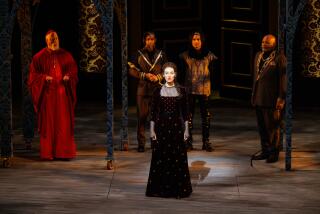Captured for Posterity, Shakespeare Without the Words
Way back when cinema was just a flickering series of images viewed in a hand-cranked machine or on makeshift screens in storefront theaters, it was considered lowbrow entertainment.
Several pioneer filmmakers, hoping to elevate the fledgling medium, began to brush up on their Shakespeare. Seeking to immortalize the Bard’s classics on film, they hired some of the biggest theater stars of the era. Even without Shakespeare’s glorious spoken words, these silent films entertained the elite as well as the masses.
A new video, “Silent Shakespeare: Such Stuff as Dreams Are Made On . . .” (Milestone Film & Video, $30), features seven of these early Shakespeare films, including the very first Bard adaptation, 1899’s “King John.” The films, which run about 10 to 20 minutes, were restored from original 35-millimeter nitrate material by the British Film Institute’s National Film and Television Archive.
Luke McKernan, now with the British Universities Film and Video Council, programmed the video and wrote a book on the silent Shakespeare films for the British Film Institute.
He points out that more than 300 silent Shakespeare films were made between 1899 and 1911. Of those, only 30 or 40 have survived.
McKernan says the seven films--”King John,” “The Tempest,” “A Midsummer Night’s Dream,” “King Lear,” “Twelfth Night,” “The Merchant of Venice” and “Richard III”--were singled out for the video because all their title cards were in English.
“A lot of silent films were exported outside the country, and every time they [exported a film], they changed the titles to that language,” McKernan says. “There are several American Shakespearean films in the archives from that period with German titles. So the first choice was we don’t want to be putting in our own titles or subtitles.”
McKernan also wanted to demonstrate the broad range of Shakespeare films that were produced during the period, from comedies to tragedies to historical plays.
“King John,” which stars legendary Shakespearean thespian Herbert Beerbohm Tree (father of noted director Carol Reed), was a recent discovery.
“The film was originally discovered in the 1940s,” he says. Unfortunately, when the collector donated it to the Netherlands’ Film Archive, it languished in a vault for several decades.
“King John” featured four scenes from the historical drama. Only one scene has survived the ravages of time. “The thing about ‘King John’ was that it was shot in 70 millimeter, a very unusual format” for the time, he says. “It was sort of a real Imax effect. The picture quality is superb.”
“King John,” McKernan points out, was shown as part of a clever multimedia strategy by the play’s producers. “When the play opened [in London on Dec. 20, 1899], the film was also made available to movie theaters. It was also made available on a machine which was like a peep show. So you could see ‘King John’ live, on the big screen and the small screen.”
The enchanting 1908 adaptation of “The Tempest,” McKernan believes, is the best of the seven “as a work of art and a model example of how to take on Shakespeare plays. If you are going to boil them down to seven or eight minutes, that’s how you did it.”
The Clarendon Film Co., he says, had never tackled Shakespeare before “The Tempest.”
“They had made little sort of social comedies, and suddenly to take on Shakespeare and to show such an understanding of the play--someone who had never seen the play before would understand it.”
American film companies also got into the Shakespeare mind-set, especially the Vitagraph Co. of America, which is represented on the tape with “A Midsummer Night’s Dream” and “Twelfth Night.” Its “Midsummer Night’s Dream” even features popular stage star Maurice Costello. However, the filmmakers tried to cram too much plot into both “Midsummer” and “Twelfth Night.” “Midsummer” even eliminates the pivotal character of Orlando for no reason while creating a new character named Penelope.
“I think they are a little too enthralled with Shakespeare,” McKernan surmises. “They had to put in every scene. Their [versions] of the tragedies get quite ludicrous. Someone comes on and stabs somebody and goes off, and you get terribly confused.”
Several of these early films also were either hand-painted or stenciled in color. The 1910 Italian productions of “King Lear” and “The Merchant of Venice” were stenciled in beautifully vibrant colors. They also feature strong performance by Ermete Novelli as Lear and as Shylock in “Venice.”
“He was one of the real giants of the Italian stage, a celebrated actor,” McKernan says. “He was in his 60s or 70s and had a lifetime of experience. He didn’t need the words any longer. It was there in every gesture.”
Frank Benson stars in “Richard III,” which features his company of actors, the genesis of the Royal Shakespeare Company.
“It was supposed to have been filmed at the Shakespeare Memorial Theater in Stratford,” McKernan says. “I don’t know how they quite got the lighting done, and it’s greatly reduced [from the play], but nevertheless it’s very close to what you would have expected to see in the theater.”
To order the video, call (800) 603-1104.
More to Read
Only good movies
Get the Indie Focus newsletter, Mark Olsen's weekly guide to the world of cinema.
You may occasionally receive promotional content from the Los Angeles Times.











